And连接的三个动词并列问题
- 格式:doc
- 大小:30.00 KB
- 文档页数:3
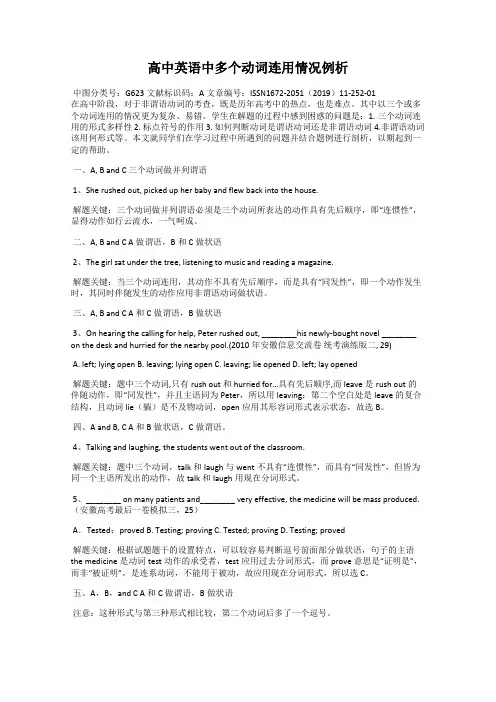
高中英语中多个动词连用情况例析中图分类号:G623文献标识码:A文章编号:ISSN1672-2051(2019)11-252-01在高中阶段,对于非谓语动词的考查,既是历年高考中的热点,也是难点。
其中以三个或多个动词连用的情况更为复杂、易错。
学生在解题的过程中感到困惑的问题是:1. 三个动词连用的形式多样性 2. 标点符号的作用 3. 如何判断动词是谓语动词还是非谓语动词 4.非谓语动词该用何形式等。
本文就同学们在学习过程中所遇到的问题并结合题例进行剖析,以期起到一定的帮助。
一、A, B and C 三个动词做并列谓语1、She rushed out, picked up her baby and flew back into the house.解题关键:三个动词做并列谓语必须是三个动词所表达的动作具有先后顺序,即“连惯性”,显得动作如行云流水,一气呵成。
二、A, B and C A做谓语,B和C做状语2、The girl sat under the tree, listening to music and reading a magazine.解题关键:当三个动词连用,其动作不具有先后顺序,而是具有“同发性”,即一个动作发生时,其同时伴随发生的动作应用非谓语动词做状语。
三、A, B and C A和C做谓语,B做状语3、On hearing the calling for help, Peter rushed out, ________his newly-bought novel ________ on the desk and hurried for the nearby pool.(2010年安徽信息交流卷统考演练版二, 29)A. left; lying openB. leaving; lying openC. leaving; lie openedD. left; lay opened解题关键:题中三个动词,只有rush out 和hurried for…具有先后顺序,而 leave是rush out的伴随动作,即“同发性”,并且主语同为Peter,所以用leaving;第二个空白处是leave的复合结构,且动词lie(躺)是不及物动词,open应用其形容词形式表示状态,故选B。
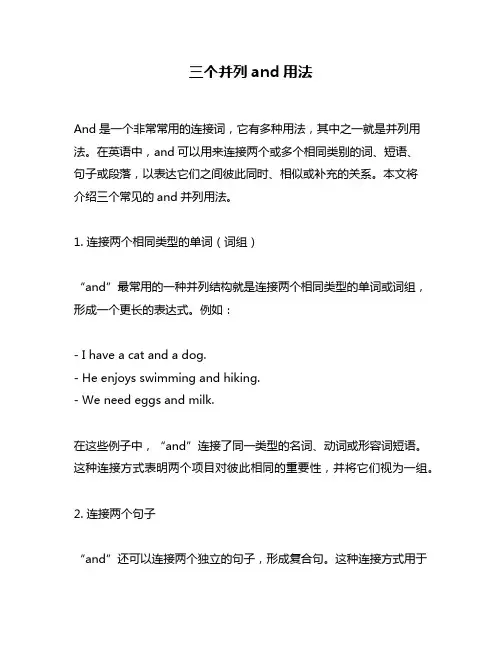
三个并列and用法And是一个非常常用的连接词,它有多种用法,其中之一就是并列用法。
在英语中,and可以用来连接两个或多个相同类别的词、短语、句子或段落,以表达它们之间彼此同时、相似或补充的关系。
本文将介绍三个常见的and并列用法。
1. 连接两个相同类型的单词(词组)“and”最常用的一种并列结构就是连接两个相同类型的单词或词组,形成一个更长的表达式。
例如:- I have a cat and a dog.- He enjoys swimming and hiking.- We need eggs and milk.在这些例子中,“and”连接了同一类型的名词、动词或形容词短语。
这种连接方式表明两个项目对彼此相同的重要性,并将它们视为一组。
2. 连接两个句子“and”还可以连接两个独立的句子,形成复合句。
这种连接方式用于描述两件事情同时发生,或两个句子之间的想法相似或插入时。
例如:- She went to the store, and he stayed home.- I don't like pizza, and I don't like pasta either.- The weather is nice today, and I'm going for a walk in the park.这些例子中,“and”连接的是两个独立的句子,每个句子都有自己的主语和谓语。
两个句子之间的关系可以是并列、附加、推理或对比。
3. 连接两个段落最后,“and”也可以用于连接两个独立的段落。
这种连接方式用于在文章中引出新的话题,或者结合前后两个段落的主题。
例如:- The first paragraph discussed the benefits of exercise, and the second paragraph will explain how to get started.- In the previous paragraph, we mentioned that climate change is a significant concern. Now, let's look at some possible solutions.这种连接方式表明两个段落之间有一个紧密联系的语义关系,可以是理由、说明、原因,或者背景资料。
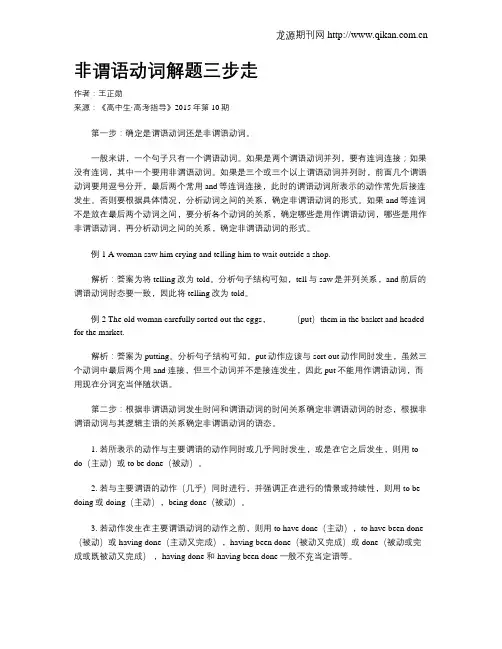
非谓语动词解题三步走作者:王正勋来源:《高中生·高考指导》2015年第10期第一步:确定是谓语动词还是非谓语动词。
一般来讲,一个句子只有一个谓语动词。
如果是两个谓语动词并列,要有连词连接;如果没有连词,其中一个要用非谓语动词。
如果是三个或三个以上谓语动词并列时,前面几个谓语动词要用逗号分开,最后两个常用and等连词连接,此时的谓语动词所表示的动作常先后接连发生。
否则要根据具体情况,分析动词之间的关系,确定非谓语动词的形式。
如果and等连词不是放在最后两个动词之间,要分析各个动词的关系,确定哪些是用作谓语动词,哪些是用作非谓语动词,再分析动词之间的关系,确定非谓语动词的形式。
例1 A woman saw him crying and telling him to wait outside a shop.解析:答案为将telling改为told。
分析句子结构可知,tell与saw是并列关系,and前后的谓语动词时态要一致,因此将telling改为told。
例2 The old woman carefully sorted out the eggs,_____(put)them in the basket and headed for the market.解析:答案为putting。
分析句子结构可知,put动作应该与sort out动作同时发生,虽然三个动词中最后两个用and连接,但三个动词并不是接连发生,因此put不能用作谓语动词,而用现在分词充当伴随状语。
第二步:根据非谓语动词发生时间和谓语动词的时间关系确定非谓语动词的时态,根据非谓语动词与其逻辑主语的关系确定非谓语动词的语态。
1. 若所表示的动作与主要谓语的动作同时或几乎同时发生,或是在它之后发生,则用to do(主动)或to be done(被动)。
2. 若与主要谓语的动作(几乎)同时进行,并强调正在进行的情景或持续性,则用to be doing或doing(主动),being done(被动)。
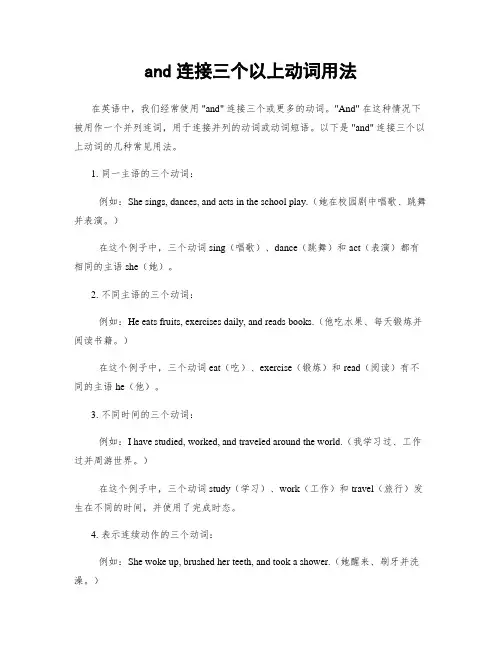
and连接三个以上动词用法在英语中,我们经常使用 "and" 连接三个或更多的动词。
"And" 在这种情况下被用作一个并列连词,用于连接并列的动词或动词短语。
以下是 "and" 连接三个以上动词的几种常见用法。
1. 同一主语的三个动词:例如:She sings, dances, and acts in the school play.(她在校园剧中唱歌、跳舞并表演。
)在这个例子中,三个动词 sing(唱歌)、dance(跳舞)和 act(表演)都有相同的主语 she(她)。
2. 不同主语的三个动词:例如:He eats fruits, exercises daily, and reads books.(他吃水果、每天锻炼并阅读书籍。
)在这个例子中,三个动词 eat(吃)、exercise(锻炼)和 read(阅读)有不同的主语 he(他)。
3. 不同时间的三个动词:例如:I have studied, worked, and traveled around the world.(我学习过、工作过并周游世界。
)在这个例子中,三个动词 study(学习)、work(工作)和 travel(旅行)发生在不同的时间,并使用了完成时态。
4. 表示连续动作的三个动词:例如:She woke up, brushed her teeth, and took a shower.(她醒来、刷牙并洗澡。
)在这个例子中,三个动词 wake up(醒来)、brush(刷)和 take(洗)表示一系列的连续动作。
无论是以上哪种用法,使用"and" 可以使我们在句子中更清楚地表达多个动作。
请注意,"and" 连接的动词应该属于同一类别,以保持句子的平衡和语法正确性。
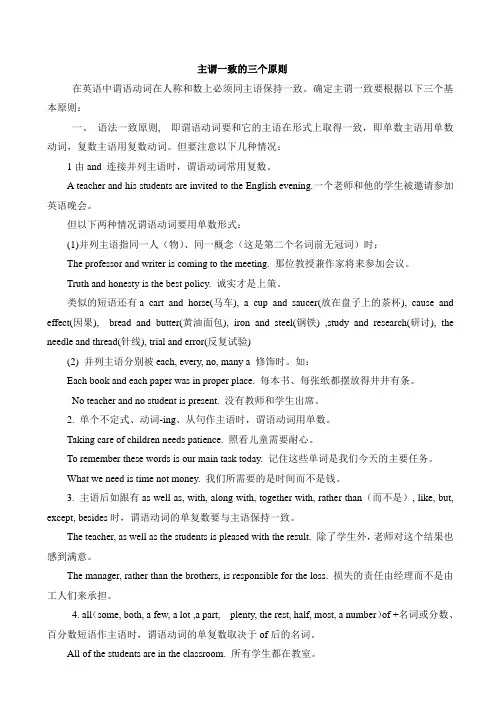
主谓一致的三个原则在英语中谓语动词在人称和数上必须同主语保持一致。
确定主谓一致要根据以下三个基本原则:一、语法一致原则, 即谓语动词要和它的主语在形式上取得一致,即单数主语用单数动词,复数主语用复数动词。
但要注意以下几种情况:1由and 连接并列主语时,谓语动词常用复数。
A teacher and his students are invited to the English evening.一个老师和他的学生被邀请参加英语晚会。
但以下两种情况谓语动词要用单数形式:(1)并列主语指同一人(物)、同一概念(这是第二个名词前无冠词)时;The professor and writer is coming to the meeting. 那位教授兼作家将来参加会议。
Truth and honesty is the best policy. 诚实才是上策。
类似的短语还有a cart and horse(马车), a cup and saucer(放在盘子上的茶杯), cause and effect(因果), bread and butter(黄油面包), iron and steel(钢铁) ,study and research(研讨), the needle and thread(针线), trial and error(反复试验)(2) 并列主语分别被each, every, no, many a 修饰时。
如:Each book and each paper was in proper place. 每本书、每张纸都摆放得井井有条。
No teacher and no student is present. 没有教师和学生出席。
2. 单个不定式、动词-ing、从句作主语时,谓语动词用单数。
Taking care of children needs patience. 照看儿童需要耐心。
To remember these words is our main task today. 记住这些单词是我们今天的主要任务。
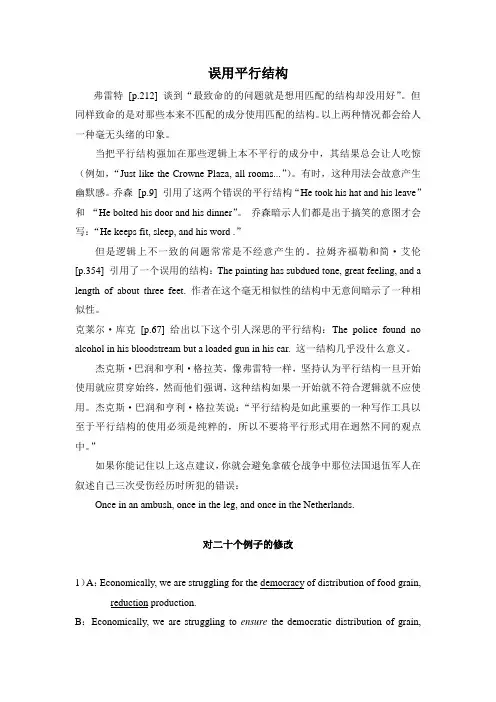
误用平行结构弗雷特[p.212] 谈到“最致命的的问题就是想用匹配的结构却没用好”。
但同样致命的是对那些本来不匹配的成分使用匹配的结构。
以上两种情况都会给人一种毫无头绪的印象。
当把平行结构强加在那些逻辑上本不平行的成分中,其结果总会让人吃惊(例如,“Just like the Crowne Plaza, all rooms...”)。
有时,这种用法会故意产生幽默感。
乔森[p.9] 引用了这两个错误的平行结构“He took his hat and his leave”和“He bolted his door and his dinner”。
乔森暗示人们都是出于搞笑的意图才会写:“He keeps fit, sleep, and his word .”但是逻辑上不一致的问题常常是不经意产生的。
拉姆齐福勒和简·艾伦[p.354] 引用了一个误用的结构:The painting has subdued tone, great feeling, and a length of about three feet. 作者在这个毫无相似性的结构中无意间暗示了一种相似性。
克莱尔·库克[p.67] 给出以下这个引人深思的平行结构:The police found no alcohol in his bloodstream but a loaded gun in his car. 这一结构几乎没什么意义。
杰克斯·巴润和亨利·格拉芙,像弗雷特一样,坚持认为平行结构一旦开始使用就应贯穿始终,然而他们强调,这种结构如果一开始就不符合逻辑就不应使用。
杰克斯·巴润和亨利·格拉芙说:“平行结构是如此重要的一种写作工具以至于平行结构的使用必须是纯粹的,所以不要将平行形式用在迥然不同的观点中。
”如果你能记住以上这点建议,你就会避免拿破仑战争中那位法国退伍军人在叙述自己三次受伤经历时所犯的错误:Once in an ambush, once in the leg, and once in the Netherlands.对二十个例子的修改1)A:Economically, we are struggling for the democracy of distribution of food grain, reduction production.B:Economically, we are struggling to ensure the democratic distribution of grain,reduce rents and interest rates, increase wages, eliminate unemployment anddevelop production.句意为:从经济上说,我们正努力保证粮食的民主分配,减少租金和利率,增加工资,消除失业,发展生产。
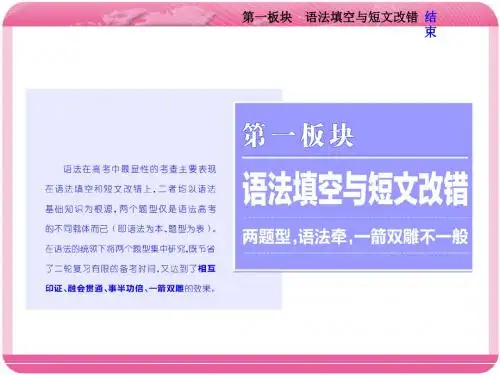
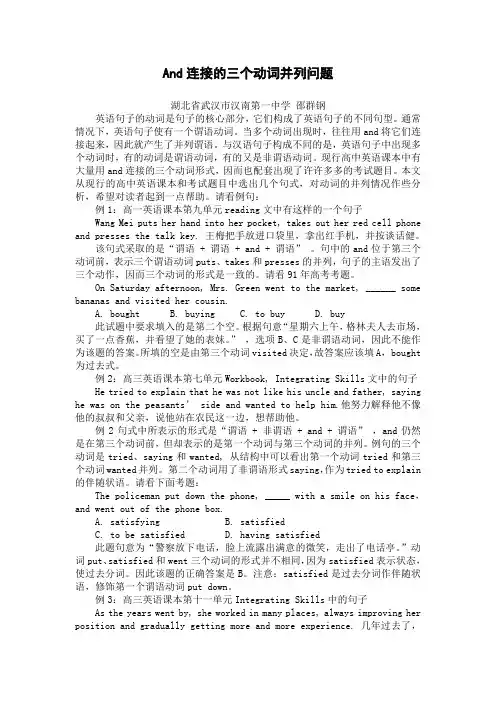
And连接的三个动词并列问题湖北省武汉市汉南第一中学邵群钢英语句子的动词是句子的核心部分,它们构成了英语句子的不同句型。
通常情况下,英语句子使有一个谓语动词。
当多个动词出现时,往往用and将它们连接起来,因此就产生了并列谓语。
与汉语句子构成不同的是,英语句子中出现多个动词时,有的动词是谓语动词,有的又是非谓语动词。
现行高中英语课本中有大量用and连接的三个动词形式,因而也配套出现了许许多多的考试题目。
本文从现行的高中英语课本和考试题目中选出几个句式,对动词的并列情况作些分析,希望对读者起到一点帮助。
请看例句:例1:高一英语课本第九单元reading文中有这样的一个句子Wang Mei puts her hand into her pocket, takes out her red cell phone and presses the talk key. 王梅把手放进口袋里,拿出红手机,并按谈话健。
该句式采取的是“谓语 + 谓语 + and + 谓语”。
句中的and位于第三个动词前,表示三个谓语动词puts、takes和presses的并列,句子的主语发出了三个动作,因而三个动词的形式是一致的。
请看91年高考考题。
On Saturday afternoon, Mrs. Green went to the market, ______ some bananas and visited her cousin.A. boughtB. buyingC. to buyD. buy此试题中要求填入的是第二个空。
根据句意“星期六上午,格林夫人去市场,买了一点香蕉,并看望了她的表妹。
”,选项B、C是非谓语动词,因此不能作为该题的答案。
所填的空是由第三个动词visited决定,故答案应该填A, bought 为过去式。
例2:高三英语课本第七单元Workbook, Integrating Skills文中的句子He tried to explain that he was not like his uncle and father, saying he was on the peasants’ side and wanted to help him.他努力解释他不像他的叔叔和父亲,说他站在农民这一边,想帮助他。

英语语法三三制原则三三制原则是英语语法中的一个原则,它指的是在使用并列连词连接三个或三个以上的并列成分时,需要遵循的一些规定。
这个原则主要适用于并列连词and、but、or以及nor,以下是三三制原则的具体规定:1.使用逗号分隔:在并列连词之前和之后需要使用逗号来分隔每一个并列成分。
例如:I like to read books, watch movies, and play sports.2.平行结构:每一个并列成分需要保持相同的结构,即同为名词、形容词、动词或者从句等。
例如:She is kind, intelligent, and hardworking. (形容词)I enjoy swimming, biking, and hiking. (动词)I have a book, a pen, and a notebook. (名词)3.强调最后一个成分:在一些情况下,可以通过强调最后一个并列成分来表达特殊的意义。
例如:I went to the store, bought some groceries, and then went home.4.不重复使用连词:在使用三个或三个以上的并列成分时,只需要使用一个并列连词,不需要在每个成分之间重复使用连词。
He likes to read books, watch movies, and play video games.5.不改变连词顺序:在并列成分之间,不改变连词的顺序。
例如:She likes to read books and watch movies.总之,三三制原则是英语语法中的一个重要原则,正确使用并列连词来连接三个或三个以上的并列成分有助于提高语言的清晰度和流畅度。
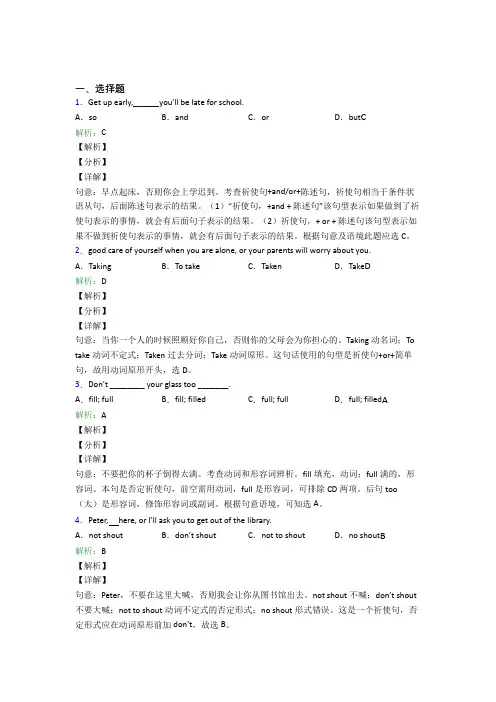
一、选择题1.Get up early,______you’ll be late for school.A.so B.and C.or D.but C解析:C【解析】【分析】【详解】句意:早点起床,否则你会上学迟到。
考查祈使句+and/or+陈述句,祈使句相当于条件状语从句,后面陈述句表示的结果。
(1)“祈使句,+and + 陈述句”该句型表示如果做到了祈使句表示的事情,就会有后面句子表示的结果。
(2)祈使句,+ or + 陈述句该句型表示如果不做到祈使句表示的事情,就会有后面句子表示的结果。
根据句意及语境此题应选C。
2.good care of yourself when you are alone, or your parents will worry about you. A.Taking B.To take C.Taken D.Take D解析:D【解析】【分析】【详解】句意:当你一个人的时候照顾好你自己,否则你的父母会为你担心的。
Taking动名词;To take动词不定式;Taken过去分词;Take动词原形。
这句话使用的句型是祈使句+or+简单句,故用动词原形开头,选D。
3.Don’t ________ your glass too _______.A.fill; full B.fill; filled C.full; full D.full; filled A解析:A【解析】【分析】【详解】句意:不要把你的杯子倒得太满。
考查动词和形容词辨析。
fill填充,动词;full满的,形容词。
本句是否定祈使句,前空需用动词,full是形容词,可排除CD两项。
后句too (太)是形容词,修饰形容词或副词。
根据句意语境,可知选A。
4.Peter, here, or I’ll ask you to get out of the library.A.not shout B.don’t shout C.not to shout D.no shout B解析:B【解析】【详解】句意:Peter,不要在这里大喊,否则我会让你从图书馆出去。

英语主谓一致的三个原则1. 形式一致的原则一般说来,当作主语的名词或代词是第三人称单数时,谓语动词就用单数形式;当作主语的名词或代词是复数时,谓语动词就复数形式:如:(1) He likes skating in winter. 他喜欢冬天滑冰。
(2) Alice reads much. 艾利斯看了很多书。
(3)They don’t live here. 他们不住这里。
2. 意义一致的原则英语中,有些名词或代词形式上是单数,而意义上可能是复数,这时,谓语动词的形式就须依据名词或代词的意义决定。
如:(1) People there were very glad to see our team win the match. 在那里的人们看到我们队赢了比赛时都非常高兴。
(2) His family were watching TV when I got to his home. 我到他家时,他家的人在看电视。
(3) Our class are working hard to make ours a good class. 我们班的同学都在努力工作以便是我们班成为优秀班。
3. 邻近一致的原则英语中,有时几个名词或代词有某些此连接起来一起作句子的主语,此时,谓语动词的形式就须有与之最接近的名词或代词的人称和数决定。
如:(1) There is a desk and five chairs in his room. 他房间里有一张办公桌和五把椅子。
(2) There are five chairs and a desk in his room. 他房间里有五把椅子和一张办公桌。
(3) Either you or Li Lei is going to be sent there. 要么是你要么是李蕾将被派到那里去。
(4) Are either you or Li Lei going to be sent there. 是你将被派到那里去还是李蕾将被派到那里去几个容易弄错的主谓一致问题1.“many a +名词”和“more than one +名词”作主语谓语动词的数通常用单数(即遵循语法一致的原则):Many a child was playing there. 很多小孩在那儿玩。
初三英语写作结构单选题30题1.She is writing a letter. In this sentence, “is writing” is _____.A.subjectB.predicateC.objectD.adverbial答案:B。
“is writing”是谓语动词,谓语就是句子中的predicate。
A 选项subject 是主语,这里的主语是“She”。
C 选项object 是宾语,此句中没有宾语。
D 选项adverbial 是状语,不符合这里的情况。
2.In the sentence “The book on the table is mine.”, “The book on the table” is _____.A.subjectB.predicateC.objectD.adverbial答案:A。
“The book on the table”是句子的主语,即subject。
B 选项predicate 是谓语,这里的谓语是“is mine”。
C 选项object 是宾语,此句中没有宾语。
D 选项adverbial 是状语,不符合这里的情况。
3.“He gave me a book.” In this sentence, “me” is _____.A.subjectB.predicateC.objectD.adverbial答案:C。
“me”是宾语,即object。
A 选项subject 是主语,这里的主语是“He”。
B 选项predicate 是谓语,这里的谓语是“gave”。
D 选项adverbial 是状语,不符合这里的情况。
4.“They are playing happily.” Here, “happily” is _____.A.subjectB.predicateC.objectD.adverbial答案:D。
“happily”是状语,即adverbial,表示“开心地”,修饰动词“playing”。
and连接的三个动词并列问题作者:邵群钢来源:《高中生·高考指导》2014年第04期英语句子中的动词是句子的核心部分,它们构成了英语句子的不同句型。
通常情况下,一个英语句子使用一个谓语动词。
当多个动词出现时,我们往往用and将它们连接起来,因此就产生了并列谓语。
与汉语句子构成不同的是,英语句子中出现多个动词时,有的动词是谓语动词,有的是非谓语动词。
现行高中英语教材中有大量用and连接的三个动词形式,因而出现了许多相关的考题。
本文选出几个句式,对主句动词的并列情况进行分析,希望对同学们有所帮助。
一、句式结构为“谓语 + 谓语 + and + 谓语”Wang Mei puts her hand into her pocket,takes out her red cell phone and presses the talk key.王梅把手放进口袋里,拿出她的红色手机,并按了通话键。
该句式结构为“谓语 + 谓语 + and + 谓语”。
句中的and位于第三个动词前,表示三个谓语动词(puts,takes和presses)的并列,句子的主语发出三个连续的动作,因而三个动词的形式是一致的。
例1 On Saturday afternoon,Mrs. Green went to the market,_______ some bananas and visited her cousin.A. boughtB. buyingC. to buyD. buy分析:答案是A。
此题中要求填入的是第二个谓语动词。
根据句意“星期六上午,格林夫人去了市场,买了一些香蕉,并看望了她的表妹”,选项B、C是非谓语动词,因此不能作为该题的答案。
所填的动词形式由第三个动词visited决定,因此答案应该选A。
bought为buy的过去式。
二、句式结构为“谓语 + 非谓语 + and + 谓语”He explained that he was not like his uncle and father,saying he was on the peasants’ side and wanted to help them.他解释他不像他的叔叔和父亲,说他站在农民这一边,想帮助他们。
高一英语--必修三词汇答案一、其他1.【答案】customer【详解】考查名词。
句意:这家餐馆的服务员都知道我。
我是这里的常客。
根据提示词以及空格前的不定冠词a 可知,此处填入可数名词customer的单数来做系动词is的表语。
故填customer。
2.【答案】【答案】unbelievable【详解】考查形容词。
句意:他的经历让人难以置信的。
根据提示词,unbelievable译为“难以置信的来做系动词is的表语。
故填unbelievable。
3.【答案】【答案】surface【详解】考查名词。
句意:表面上他似乎很诚实,但实际上他并不可靠。
空格处用名词作宾语,“表面”的名词是surface,“on the surface”是固定短语,意为“表面上”,因此空格处是surface,故填surface。
4.【答案】exists【详解】考查时态和主谓一致。
句意:月球上什么也不存在,因为没有水和空气。
空格处是谓语,用动词,“存在”是exist,句子描述客观事实,时态用一般现在时,Nothing是不定代词,其后谓语动词用第三人称单数,因此空格处是exists,故填exists。
5.【答案】passage【详解】考查名词。
句意:我付不起去澳大利亚的旅费。
“船费”是名词passage,是不可数名词,故填passage。
6.【答案】violent【详解】考查形容词。
句意:不应该允许孩子看任何暴力电影。
空处应填形容词作定语,修饰名词movie,根据汉语提示可知,violent暴力的。
故填violent。
7.【答案】【答案】cucumbers【详解】考查名词。
句意:蘑菇和黄瓜是蔬菜但不是水果。
空处应填名词作主语,根据汉语提示可知,cucumber 黄瓜,是可数名词,此处用复数形式cucumbers。
故填cucumbers。
8.【答案】sighed【详解】考查动词。
句意:“哦,这次比赛输了。
希望我们下次能有更好的运气,”她叹了口气。
英语改错简单技巧口诀英语改错简单技巧口诀导语:所谓”知己知彼,百战不殆“,短文改错到底考,通过以下口诀我们就一目了然了!跟着店铺一起去详细了解一下吧。
改错技巧口诀一、查时态是否一致时态错误几乎是每年NMET短文改错中必设的改错题。
要有目的地去检查文中的每一个谓语动词的时态与上下文、语境以及该句的时间状语是否相符和一致。
例如:1.Today, it is much easier to be healthy than it is inthe past. (NMET‘ 93)is 应改为was,使之与时间状语in the past一致。
2.I had always wanted to return to the village aftermoving away. And it is really grea t to see most of my oldfriends again. (NMET’ 95)is 应改为was,与前面分句的时态一致。
3.They offered me coffee and other drinks. We have a goodtime talking and laughing together .(NMET‘ 96) have 与前面句子中offered时态不一致,应改为had。
4.Hello,I learn about you from my English teacher,MissFang.(NMET’97)learn(得知)在这里不是表示一个经常发生的动作,应改为过去时learned。
(本来此处还可改为have learned,由于“短文改错” 题要求,每行只允许改一个错误,故have learned不能接受。
)5.My favourite sport is football.I was a member of ourfootball team.(NMET‘98)全文都是用的一般现在时,此句中的was显然与上下文语境不符,应改为am。
高三英语(课标全国卷)并列句和状语从句1. 掌握并列连词的基本用法及句式。
2. 掌握状语从句从属连词的基本用法。
一、并列句并列连词连接两个互不依存的词、短语或分句。
并列连词连接两个分句就构成了并列复合句。
(一)并列句思维导图(二)表示顺承或递进关系:and,both.. and..., not only..but (also)., as well as, neither...nor...等。
1. and;①意为“和,与,且,又”,表顺承、递进关系;②表示动作长时间地“继续”或“重复”。
Local people live in old houses and they are very friendly.当地人生活在旧房子里并且他们很友好。
We waited and waited.我们等了又等。
2. both…and…意为“既……又……,两个都”。
He spoke with both kindness and understanding. 他说话既亲切又明事理。
3. not only…but(also)….意为“不仅……而且.….…”。
Not only men but (also) women were chosen. 选中的不仅有男性还有女性。
4. as well as 意为“也,还”。
They have a flat in town as well as in the countryside. 他们在城里有一套公寓,在乡村也有。
5. neither….nor…意为“既不……也不……”。
Neither Tom nor Helen is hard-working. 汤姆和海伦都不勤奋。
(三)表示转折或对比关系:but,yet, not... but…,while 等。
1. but意为“但,而,然而”,表示转折关系,不能与从属连词 although, though, while 连用。
There are many kinds of sports, but my favorite is swimming. 有许多种运动,但我最喜欢的是游泳。
主谓一致使用主谓一致时,必须遵循三个原则,即语法一致原则、意义一致原则和就近一致原则。
一、当单数可数名词、不可数名词、复合不定代词、单个不定式(疑问词+不定式)、动名词或主语从句以及表示“时间、价值、重量、距离、书名、影片名称”等名词作主语时,谓语动词通常用单数形式。
例如:The curtains are closed and the living room is dark when Mom and Dad enter.Visiting a place like this is always very interesting.Why pleasant smells do not reduce pain in men is a question still to be answered by scientists.二、 all(some, a lot, plenty, any, part, the rest, most等)+ of +名词作主语以及分数、百分数构成短语作主语时,谓语动词单复数形式取决于 of 后的名词或代词。
表示复数概念用复数;表示单数概念用单数。
例如:As a result of the serious flood, two-thirds of the buildings in thearea need repairing.One study says that 90% of our time is spent watching television or using computers.While the rest of the passengers were getting out, she glanced at thefaces around her.三、在“名词 / 代词+介宾结构+谓语+⋯”结构中,谓语动词与名词/代词保持一致,介宾结构看作插入成分。
该结构中的常见介词及介词短语有 with, together with, along with, as well as, like, but, except,besides, including等。
And连接的三个动词并列问题
湖北省武汉市汉南第一中学邵群钢
英语句子的动词是句子的核心部分,它们构成了英语句子的不同句型。
通常情况下,英语句子使有一个谓语动词。
当多个动词出现时,往往用and将它们连接起来,因此就产生了并列谓语。
与汉语句子构成不同的是,英语句子中出现多个动词时,有的动词是谓语动词,有的又是非谓语动词。
现行高中英语课本中有大量用and连接的三个动词形式,因而也配套出现了许许多多的考试题目。
本文从现行的高中英语课本和考试题目中选出几个句式,对动词的并列情况作些分析,希望对读者起到一点帮助。
请看例句:
例1:高一英语课本第九单元reading文中有这样的一个句子
Wang Mei puts her hand into her pocket, takes out her red cell phone and presses the talk key. 王梅把手放进口袋里,拿出红手机,并按谈话健。
该句式采取的是“谓语 + 谓语 + and + 谓语”。
句中的and位于第三个动词前,表示三个谓语动词puts、takes和presses的并列,句子的主语发出了三个动作,因而三个动词的形式是一致的。
请看91年高考考题。
On Saturday afternoon, Mrs. Green went to the market, ______ some bananas and visited her cousin.
A. bought
B. buying
C. to buy
D. buy
此试题中要求填入的是第二个空。
根据句意“星期六上午,格林夫人去市场,买了一点香蕉,并看望了她的表妹。
”,选项B、C是非谓语动词,因此不能作为该题的答案。
所填的空是由第三个动词visited决定,故答案应该填A, bought 为过去式。
例2:高三英语课本第七单元Workbook, Integrating Skills文中的句子He tried to explain that he was not like his uncle and father, saying he was on the peasants’ side and wanted to help him.他努力解释他不像他的叔叔和父亲,说他站在农民这一边,想帮助他。
例2句式中所表示的形式是“谓语 + 非谓语 + and + 谓语”,and仍然是在第三个动词前,但却表示的是第一个动词与第三个动词的并列。
例句的三个动词是tried、saying和wanted, 从结构中可以看出第一个动词tried和第三个动词wanted并列。
第二个动词用了非谓语形式saying,作为tried to explain 的伴随状语。
请看下面考题:
The policeman put down the phone, _____ with a smile on his face,and went out of the phone box.
A. satisfying
B. satisfied
C. to be satisfied
D. having satisfied
此题句意为“警察放下电话,脸上流露出满意的微笑,走出了电话亭。
”动词put、satisfied和went三个动词的形式并不相同,因为satisfied表示状态,使过去分词。
因此该题的正确答案是B。
注意:satisfied是过去分词作伴随状语,修饰第一个谓语动词put down。
例3:高三英语课本第十一单元Integrating Skills中的句子
As the years went by, she worked in many places, always improving her position and gradually getting more and more experience. 几年过去了,
她在许多地方工作过,情况总是不断地改善,而且还逐渐获得了越来越多的经验。
例3句式结构为“谓语 + 非谓语 + and + 非谓语”。
此句式结构中and 位于第三个动词前,第一个动词作句子的谓语,而第二个动词与第三个动词并列(两个非谓语动词)。
此句式的第三个动词限制了第二个动词。
但当第三个动词是谓语时,它并不能绝对限制第二个动词。
例句中improving和getting是现在分词作worked的伴随状语。
请看下面的试题:
He sat there in silence,_____ sad and doing nothing.
A. looking
B. looked
C. and looking
D. and looked
试题空格中的正确选项是A。
它受到第三个动词doing的限制,它们在句中也作伴随状语。
此句式结构中的非谓语动词部分用作谓语动词的伴随状语,也可以到句首。
例如:
Talking and laughing, the girls walked to the school.(分词并列,用作伴随状语)
To protect themselves from being eaten and to survive in the wild, many animals have developed clever ways to escape from or avoid danger.(高三英语第十四单元Workbook. Reading 1)(不定式并列,用作目的状语)例4:高二英语课本第十单元reading文中的句子
He bathed and had dinner, giving everyone the impression that there was no danger at all.他洗了澡,吃了饭,给大家一种根本就没有危险的印象。
例4句式形式为“谓语 + and + 谓语 + 非谓语”。
此句式结构中的and 在第二个动词前面,表示第一个动词与第二个动词并列。
第三个动词用非谓语形式,在句中状语。
课文例句中,giving用作伴随状语,修饰bathed和had。
请看04年上海春季高考考题:
Suddenly, a tall man driving a golden carriage _____ the girl and took her away, ______ into the woods.
A. seizing; disappeared
B. seized; disappeared
C. seizing; disappearing
D. seized; disappearing
这道试题所设置的是英语句子中的谓语与非谓语的区别。
解这道题目,需要考虑动词的并列情况。
此句中and连接的并列动词又是什么呢?非谓语动词driving作为名词man的定语,此处可不必考虑;句子中took该与什么并列呢?根据and在took前,可以断定,它应该与句子中第一空并列,而与第二空不并列,第二空用作took的结果状语,应填现在分词。
因此此题的正确答案是D。
例5:句式结构为“谓语 + and + 非谓语 + 谓语”。
此句式结构课文中没有相应的句式,先列举一个例子:
He finished his breakfast, and putting on a hat, went out of the house.他吃完早饭,戴上帽子后,走出了家门。
该剧结构中的and位于第二个动词前,是第一个动词与第三个动词并列,第二个动词是非谓语形式。
请看试题:
Those women stood at the gate chatting and seeing the manager, _______ in a hurry.
A. leaving
B. to leave
C. left
D. would leave
试题中有四个动词,chatting作为stood的伴随状语。
and连接的并列谓语应是stood和空格中的动词,seeing作为后面动词leave的时间状语。
因此该题应选C为正确答案。
以上这些是and连接的并列动词所出现的基本形式,其它可以出现的句式为:非谓语 + 谓语 + and + 谓语。
如:Helped by two slaves he stood up, and immediately fell down dead.(高三英语第十单元Reading)
动词并列的结构不同,因而动词的并列形式也有差异。
在解答这类题目时,学生应该注意的是句中and的位置, 再观察四个选项。
它通常包含了位于形式的动词和非谓语形式的动词,因而我们应该注意并列动词的分析。
掌握以上三个动词的并列,两个动词或者是三个以上的动词的练习题就能迎刃而解了。